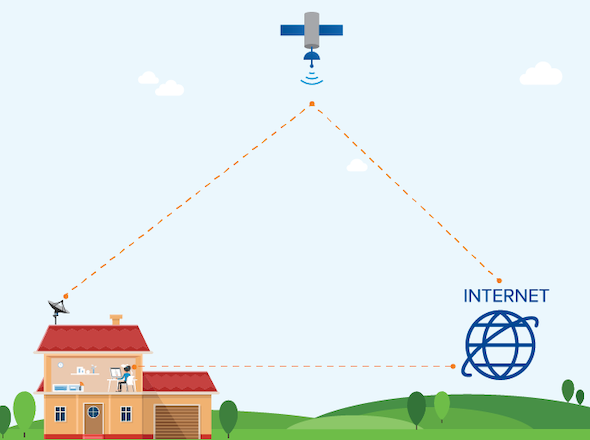How Does Satellite Internet Work?
Satellite internet connects homes and businesses across the country. Other internet services require extensive and expensive infrastructure, frequently unavailable in rural locations. In contrast, satellite internet only requires a satellite dish and modem for reliable connectivity, no matter how remote your location.
So how does satellite internet work, and what are its benefits? Here, we’ll break down the basics, from how satellites transmit internet data to installation requirements and availability in your area.
The Fundamentals of Satellite Internet

Orbiting Satellites & Ground Stations
There are three main types of orbiting satellites: low Earth orbit (LEO), medium Earth orbit (MEO), and geostationary Earth orbit (GEO). Each serves different purposes, from GPS and Earth observation to communications. Hughesnet® uses geostationary satellites (GEO), which remain fixed over one point on the Earth’s surface, allowing us to provide broad internet coverage across the United States—even in rural or remote areas where landline coverage is not available.
Data Transmission Flow: A Primer
For home satellite internet, data travels from the home’s satellite dish to the orbiting satellite, to the ground station, out to the internet, and then back again. Here’s how the process works:
Step 1: A request for a Web page is sent from your computer to a satellite about 22,000 miles out in space. At this altitude, the satellite's period of rotation (24 hours) matches the Earth's, and the satellite always remains in the same spot over the Earth (geosynchronous orbit).
Step 2: The satellite contacts the Hughes Network Operations Center (NOC) which locates the specific Website you have requested.
Step 3: The Website beams the information back along the same path to the NOC, then to the satellite, and then to your computer or device through your Hughesnet dish and modem.

Connections Where You Love to Live
With satellite internet, you no longer need to sacrifice connectivity to live where you want. Orbiting satellites and ground stations make it possible to deliver internet connections wherever you live. Hughesnet continues to improve satellite internet technology through innovations like the Hughesnet Fusion® plan, which combines satellite and wireless technologies to provide a low-latency internet experience. Fusion plans use multipath technology to offer a fast and responsive experience with added reliability.
Explore Fusion availability and Hughesnet satellite internet options where you live.
